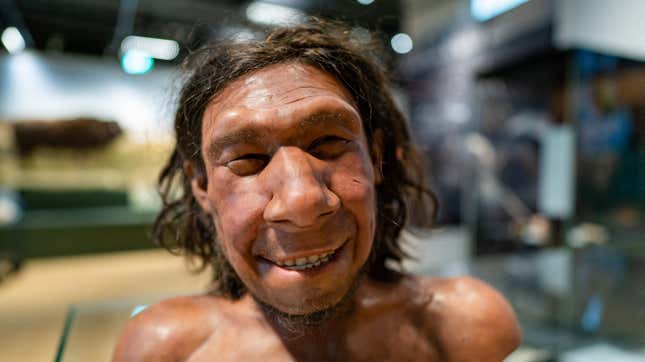
A sweeping analysis of European and Asian genomes over the last 40,000 years reveals when and how some genetic exchange occurred between Homo sapiens and our closest cousins, Homo neanderthalensis. It also shows how the Neanderthals’ genetic footprint depended on later exchanges between members of our own species.
Neanderthals are an extinct species of hominin that lived in Europe and Asia until about 40,000 years ago. Remains of Neanderthals were first found in a German quarry in 1856; their bones revealed a big-browed, barrel-chested human species. But the advent of ancient DNA research has revealed the genetic diversity within the group, as well as their close relation to us.
Recent evidence has shown that Neanderthals were not fully wiped out by our own species; rather, they were slowly subsumed by Homo sapiens through episodes of interbreeding. Those episodes have been revealed thanks to advances in paleogenetics, which has made DNA locked away in Neanderthal teeth and modern humans a window into the ancient interactions of the two hominins.
Now, a team of researchers has studied 4,464 Eurasian genomes, both ancient and modern, and modeled how the genomes interrelated based on their geographic origins and age. The team’s findings are published today in Science Advances.
They found that early farmers expanding out from Anatolia and the Levant with less Neanderthal ancestry diluted the amount of Neanderthal ancestry in European populations beginning around 10,000 years ago, explaining the higher proportion of Neanderthal ancestry in East Asian populations compared to Western European ones. Neanderthal bones have been found as far east as the Altai mountains in Central Asia, but most Neanderthal remains have been found in western Eurasia, like those on the island of Jersey which indicated that early modern humans and Neanderthals hybridized.
Earlier computer simulations by the research team indicated that, when a population migrates and hybridizes with a different group elsewhere, subsequent generations will have a percentage of local DNA that’s proportional to the amount of distance the migrating population came from. In other words, the farther out of Africa Homo sapiens moved, the more Neanderthal DNA they’d have in their genomes.
“While we observed this gradient when analyzing the paleogenomes of hunter-gatherers during the Paleolithic, this was not enough for explaining the higher level of Neanderthal ancestry observed today in East Asia compared to Western Europe,” Claudio Quilodrán, a researcher at the University of Geneva and co-first author of the research, told Gizmodo in an email. “We need the second range expansion of early farmers from Anatolia-Levant, which replaced hunter-gatherers in Europe, to explain the current distribution of Neanderthal ancestry.”
Quilodrán’s team looked at genomes that were 40,000 years old and younger from the Allen Ancient DNA Resource at Harvard Medical School. The genomes showed how Neanderthal DNA was diluted in human genomes following the species’ disappearance from the fossil record.
“Note that when we say that the levels of Neanderthal ancestry are higher or lower in some regions, we are talking about small differences that are possible to distinguish today with the accumulation of paleogenomes,” Quilodrán added. “The overall level of Neanderthal ancestry is about 2%, but this level today is 8% to 24% higher in East Asia.”
Though the focus of the paper was on populations in Eurasia—Neanderthals’ ancient stomping ground—in 2020, a different group of researchers found that modern African populations do have some Neanderthal DNA, which conflicted with a previous assumption that people who left Africa and bred with Neanderthals never returned.
More of the history of genetic exchange between our species and our closest cousins could yet be revealed by more modeled analysis, hand-in-hand with more paleoanthropological finds. The two lines of study inform each other, giving us a fuller picture of how our modern genetic diversity took shape.
More: Neanderthal and Denisovan DNA Discovered in Ancient South Americans